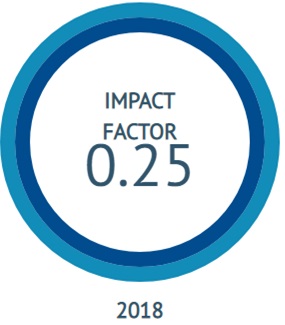Physiological Status of Fattening Bali Cattle Feeding a Concentrate Containing Gliricidia sepium Leaves Meal Fortified with Vitamin B-Complex and Vermicide
Abstract
This research has been conducted at Oeletsala village, for 10 weeks from 23 November 2015 to 23 January 2016, comprised of 2 weeks preliminary and 8 weeks for data collection. The aim of the research was to study the effect of feeding a Gliricidia sepium leaves meal concentrate fortified with B. complex vitamin and vermicide on rectal temperature, respiratory frequency, and heart rate of fattening Bali cattle. Experimental animals used were nine young male Bali cattle of 1.5-2 years old, with an initial body weight ranging from 82 to 124 kg (KV=15.114%) in average of 98.7±14.93 kg. The experimental design used was Randomized Block Design with three treatments and three replications. Those treatments were R0 = leaves of Leucaena leucocephala and Ceiba pentandra+ native grass ad libitum (as commonly practiced by local farmers), R1 = R0 + 2 kg concentrate, and R2 = R1 + B. complex vitamin, and vermicide. Statistical analysis showed that there was no significant effect of the treatments on rectal temperature, respiratory frequency, and heart rate of the fattening Bali cattle(P ≤ 0.05).In conclusion, there was no significant effect of Gliricidia sepium leaves meal concentrate, vitamin B. complex, and vermicide on rectal temperature, respiratory frequency, and heart rate of the fattening Bali cattle.
Keywords: concentrate, B complex vitamin, worm vermicide, rectal temperature, respiratory frequency, and heart rate
Downloads
References
Ayu A, Erwanto, Santosa PE. The Effect of Providing ForageConcentrate on Physiological Response and Performance of Simmental Cross Beef Cattle. Jurnal Ilmiah Peternakan Terpadu. 2015; 3 (4) : 201-207.
Astuti A, and Sudarman A. Physiological Status, Blood Profile and Body Composition of Sheep Fed With Ca-Saponified Lemuru Oil Coated by Herbs. Buletin Peternakan. 2015; 39 (2):116122. DOI: https://doi.org/10.21059/buletinpeternak.v39i2.6716
Ake AS, Ayo JO, and Aluwong T. Effects of transportation and thermal stress on donkeys in the Northern Guinea Savannah zone of Nigeria: A review. Journal of Cell and Animal Biology. 2013;
7 (8): 92-101. DOI: https://doi.org/10.5897/JCAB2013.0370
Aradom S. Animal Transport and Welfare with Special Emphasis on Transport Time and Vibration. Doctoral Thesis: Faculty of Natural Resources and Agricultural Sciences, Department of Energy and Technology Uppsala. Swedish University of Agricultural Sciences. 2013; Uppsala.
Bulitta FS, Aradom S, and Gebresenbet G. Effect of transport time of up to 12 hours on welfare of cows and bulls. Journal of Service Science and Management. 2015; 8: 161-182. DOI: https://doi.org/10.4236/jssm.2015.82019
Eniolorunda E. Fashina, and Aro. Adaptive physiological response to load time stress during transportation of cattle in Nigeria. Journal of Archive Zootechnology. 2009;58 (222): 223-230.
Ewing SA, Lay DCJR, and Borell EV. Farm animal well being stress physiology animal behavior and environmental design. Prentice- Hall.Inc. New Jersey. 1999.
Farooq U, Samad HA, Shehzad F, and Qayyum A. Physiological responses of cattle to heat stress. Journal of World Applied Sciences, (Special Issue of Biotechnology and Genetic Engineering); 2010. 8: 38-43.
Gaughan JB, Davis MS, and Mader TL. Wetting and the physiological responses of grain-fed cattle in a heated environment. Aust. J. Agric. Res. 2004; 55: 253-260. DOI: https://doi.org/10.1071/AR03110
Genswein KS, Faucitano L, Dadgar S, Shand P, González LA, and Crowe TG. Road transport of cattle, swine and poultry in North America and its impact on animal welfare, carcass and meat quality: a review. Journal of Meat Sciences. 2012. 92 (3): 227-43. DOI: https://doi.org/10.1016/j.meatsci.2012.04.010
Kendall PE, Verkerk GA, Webster JR, and Tucker CB . Sprinklers and shade cool cows and reduce insect-avoidance behavior in pasture-based dairy systems. J. Dairy Sci. 2007; 90: 36713680. DOI: https://doi.org/10.3168/jds.2006-766
Knowles TG. Review of the Road Transport of Cattle. Veterinary Record. 1999; 144: 8: 197-201. DOI: https://doi.org/10.1136/vr.144.8.197
Sporer KRB, Weber PSD, Burton JL, Earley B, and Crowe MA., Transportation of young beef bulls alters circulating physiological parameters that may be effective biomarkers of stress. Journal of animal Science. 2014; 86:1325-1334. DOI: https://doi.org/10.2527/jas.2007-0762
Swenson M.J and Reece WO. Duke’s Physiology of Domestic Animals. 11th Edn. Comstock Publishing Associates. 1993.
West JW. Effect of heat-stress on production in dayri cattle. J Dairy Sci. 2003; 6: 2131. DOI: https://doi.org/10.3168/jds.S00220302(03)73803-X
Copyright (c) 2018 Universitas Nusa Cendana

This work is licensed under a Creative Commons Attribution-NonCommercial-ShareAlike 4.0 International License.

 Sukawaty Fattah(1*)
Sukawaty Fattah(1*)










